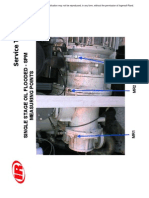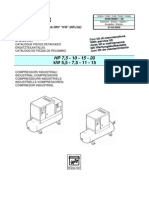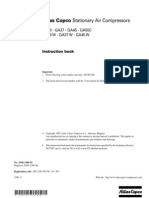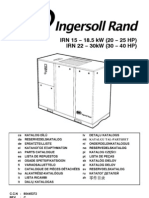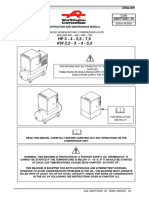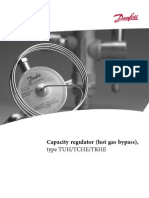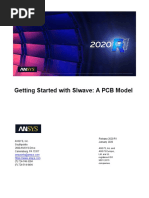Manual Ir30 Parte 1
Manual Ir30 Parte 1
Uploaded by
Romero AndradeCopyright:
Available Formats
Manual Ir30 Parte 1
Manual Ir30 Parte 1
Uploaded by
Romero AndradeOriginal Description:
Copyright
Available Formats
Share this document
Did you find this document useful?
Is this content inappropriate?
Copyright:
Available Formats
Manual Ir30 Parte 1
Manual Ir30 Parte 1
Uploaded by
Romero AndradeCopyright:
Available Formats
Instruction Manual
IR30 BEARING MONITOR
Sentinel Model
APDD 766A
MARCH 2003
IR-30 SENTINEL
IR 30 Shock Pulse Instrument
Manual Contents List
Section
Title
IR 30 Sentinel Instrument Parts List
Shock Pulse Monitoring, A Snapshot
Data Acquisition with the IR30
When Is There A Problem?
Required Documentation for Airend Replacement
Measuring Points on Ingersoll-Rand Units
Data Acquisition on a Nirvana
dBi and dBm values for Ingersoll-Rand Units
SPM Logs
Confidentiality
The contents of this publication may not be reproduced in any
form without the permission of Ingersoll-Rand.
IR30
2003 Ingersoll-Rand Company
Date of Issue: March 2003
IR-30 SENTINEL
IR 30 SENTINEL Shock Pulse Instrument
54636536 Kit Contains:
Quantity
CCN
Part Name
54636519
IR 30 Sentinel Instrument
39262837
TRA 22 Probe
39262928
9022 Batteries (AA Size)
( Installed In Instrument )
54636527
Instruction Manual Package
APDD 766A
CAS-09 Carrying Case
Possible Upgrades
CCN
Part Name
39262845
TRA 31 Quick Connector (for stud mounted units)
38034872
Vibration attachment kit
38332284
IR30 Sentinel Upgrade to Logger (unit upgrade only, no
additional attachments included)
42464602
Set of 50 Adapters and Caps to stud mount units
39262993
Chamfer Drill (to drill holes for studs)
IR30
2003 Ingersoll-Rand Company
Date of Issue: March 2003
IR Confidential: The contents of this publication may not be reproduced, in any form, without the permission of Ingersoll-Rand.
IR-30 SENTINEL
SHOCK PULSE MONITORING, SPM INSTRUMENTS, IR-30
"A SNAPSHOT"
Unless an individual is involved with some form of machinery vibration analysis, the term "Shock
Pulse" (Monitoring) is unknown and somewhat foreign. Officially, and accurately, it is a technology
relying on the physical principle that sound travels undiminished through metal objects for great
distances. The second principle involved is that of resonance. The measuring instrument is
equipped with a 30,000 Hertz electrically tuned device, which resonates and records certain shock
frequencies emitted by roller bearings.
This explanation, while accurate, loses most people, and leaves them cold.
A simpler, if somewhat inaccurate, illustration enables an easier visualization, and invites very
good credibility.
Using a freight train as an example, visualize sitting at a rail crossing waiting for the train to pass.
We've all done this at one time or another. As the train cars pass, you hear the usual sound of the
wheels rolling against the steel tracks, and the normal "clickety-clack" as the wheels cross the rail
joints. The sound varies, louder as the heavier cars pass, less intense as the empty cars pass. That
is the usual sound, and can be called in Shock Pulse terminology as "Decibel Carpet". Floor,
bottom, average sound of a freight train rolling by, if you will.
While the train is passing, a car, loaded with coal approaches. This particular car has a flat spot
on one of its wheels. Rail car wheels get flat spots when the car is empty, has been sitting in the
yard for a long time, and a brake shoe sticks to a wheel rim. The car is coupled to a train for use,
and when it starts to move, the wheel can't turn because of the stuck brake shoe. Eventually, speed,
vibration and sheer impact will tear the brake loose and the wheel begins turning. However, after
being dragged for some distance on a steel rail unable to turn, the wheel now has a flat spot.
It is easy to imagine how this flat spot will sound as it hits the rail with each revolution. This
sound, a repetitive "banging",
heard well above the "Decibel
Carpet", now becomes
"Decibel Max", (maximum), the
second term to be understood
in Shock Pulse terminology.
The third term is "Decibel
Initial", and this is a factor,
which can be likened to
calibrating the listener's ear as
the train passes. This
"calibration" regulates the
intensity with which ear
perceives Decibel Max, and
Decibel Carpet. These terms are abbreviated, "DBI", "DBM", and "DBC".
IR30 Snapshot
2001 Ingersoll-Rand Company
Date of Issue: January 2001
IR Confidential: The contents of this publication may not be reproduced, in any form, without the permission of Ingersoll-Rand.
IR-30 SENTINEL
Applying the technology to steel roller bearings requires only reasonable access to the outside
diameter of the monitored bearing through an uninterrupted metal path. Permanently attached metal
studs are best for this purpose. A mechanical "clip-on" accelerometer is used to anchor to and read
the acoustical signature from the bearing, through the housing to the studs.
A hand held, contact probe can also be used with good results. The Instrument, which reads the
shock pulse DBM/DBC values and displays them as two numerical values is called the "IR-30". Any
type of steel roller bearing can be monitored.
The technology has no application to sleeve bearings.
Data acquisition is a simple process. First, Decibel Initial value for the particular bearing(s) must be
determined. For this, the inside diameter of the bearing must be known. Shaft diameter upon which
the bearing is mounted is usually easiest to determine. Where two different diameter bearings are
used on a shaft with near equal loads on both ends, an average of both diameters is used. Shaft
rotative speed is also needed. Entering these figures into the IR-30 yields the Decibel Initial (DBI)
value for those bearings.
The sites on the machine for bearing probe points are then determined. We try to use bearing
housing flange edge surfaces, since these areas have ample depth, are free of air or oil passages,
and provide a direct (if somewhat curving) solid metal path to the outer race of the subject bearing.
Studs are fitted by drilling and tapping sites with M8 or 5/16" - 18P threads, 1/2" deep, with a 90
Degree entering chamfer.
Manual data acquisition consists of operating the machine in loaded and in unloaded condition,
while measuring DBM/DBC values with the instrument. As each site value is determined, it can be
electronically stored in the instrument for later downloading to a PC and printing. Electronic
recording requires use of "CondMaster Pro" software provided by Ingersoll-Rand with purchase of
the Logger (full package) instrument.
Manual recording of the data can also be done on paper logs, designed by the user to suit the
purpose. Normally, data is taken monthly
for the first three months of operation of a
new machine, then quarterly.
DBM/DBC values are indicators of
bearing condition, and of bearing
deterioration. As a general rule, DBM
values, on new equipment of oil flood/ oil
free compressors, will run in the 20 to 40
range. DBC, about half DBM. Data is
reviewed, and DBM values which rise in
the 45 range and above, particularly when
unit is loaded, are to be noted. DBC will
also rise, coming close to DBM. Two
consecutive DBM readings at or above 55
in 700 hours signal need to consider
bearing overhaul.
IR30 Snapshot
2001 Ingersoll-Rand Company
Date of Issue: January 2001
IR Confidential: The contents of this publication may not be reproduced, in any form, without the permission of Ingersoll-Rand.
IR-30 SENTINEL
Sudden changes are to be especially noted, and monitor frequency "doubled up". A cracked or
loosened inner race will result in such drastic changes, and must receive immediate attention.
Oil Free Compressors will display consistent DBM as 10, 15 points higher than DBC in normal
running condition, loaded or unloaded.
Oil flooded single stage units seem to display closer DBM/DBC points than oil free, and when
running unloaded DBM/DBC will be equal to or higher than loaded. When gas load is relieved,
rotors seem to become more unstable and "rattle around" in the bearing clearances more.
Oil flooded two stage units display DBM/DBC loaded points consistent with single stage and oil
free machines. However, unloaded DBM/DBC seem to run at or considerably higher than loaded
figures. Therefore, on oil flooded units, loaded DBM/DBC figures are to be considered dominant
decision points. Drive motor bearings behave in similar manner.
Two stage units have four bearing points per casing. The shock pulse emission from the four
points radiates and overlaps as it is read from the casing flanges. However, trending, and observing
loaded DBM/DBC using these guidelines should yield accurate indications of repair requirements.
IR30 Snapshot
2001 Ingersoll-Rand Company
Date of Issue: January 2001
IR Confidential: The contents of this publication may not be reproduced, in any form, without the permission of Ingersoll-Rand.
IR-30 SENTINEL
Key Path
Display 16x Characters
Instrument Type
Light Sensor
Measuring Key
Set Key
Select Key
Left/Right Arrow Keys
Up/Down Arrow
Keys
Input Connector SPM
Input Connector Software +
Input Connector Vibration
IR30 Data Acquisition
2001 Ingersoll-Rand Company
Date of Issue: August 2001
IR Confidential: The contents of this publication may not be reproduced, in any form, without the permission of Ingersoll-Rand.
IR-30 SENTINEL
Instrument Type
IR30 Sentinel
Measuring Key
Function key used to record IR30 measurements
Set Key
Function key used to set in menu options
Left/Right Arrow Keys
Keys used to scroll around menu options
Input Connector SPM
Connection point for SPM instruments.
Input Connector Software
Data communication to to interface to PC (if applicable)
Display 16x Characters
Text Menu (Available in muli-languages)
Light Sensor
Sensor to detect light level and automatically switches on
background light if selected.
Select Key
Function key used to enter fields from menu
Up/Down Arrow Keys
Keys used to change options highlighted and move up and downloaded rounds.
Input Connector Vibration
Connection point for Vibration instrument.
IR30 Data Acquisition
2001 Ingersoll-Rand Company
Date of Issue: August 2001
IR Confidential: The contents of this publication may not be reproduced, in any form, without the permission of Ingersoll-Rand.
IR-30 SENTINEL
DATA ACQUISITION, I-R 30 SENTINEL INSTRUMENT
Step1: Press M on instrument keypad, Screen should show SPM; dbm, dbc lower left, and dbi lower
right. If screen does not show SPM press the Left or Right Arrow until it does.
Press SET, Screen will appear; see Bearing Data
TLT (Transducer Line Test) Off or On. Using the Up or
Down Arrows, Set to On. After a reading has been taken,
TLT values above 15 will indicate no signal loss between
the instrument and the transducer.
Bearing data
TLT on
. rpm
. dmm
dBi 26
If BDI is known for a particular reading point (see dbi
tables), press SET until the cursor is at dbi ____. Using
the Up or Down Arrow adjust field to register desired dbi
value. Press Ent", see return to SPM screen. You are now ready to take data, using the hand held
probe. (Go to step 2)
If dbi is unknown, then: Press Set, see _____rpm. Using the Left or Right Arrow, traverse blank
fields to desired point. Using the Up or Down Arrow, with Left or Right Arrow, adjust field to register
desired shaft speed.
Press Set, see _____dmm or inch. This is shaft diameter. Using the Up or Down Arrow, with the Left or
Right Arrow, adjust field to register desired shaft diameter.
Press Set, see dbi ____ which is decibel initial. This is the calculated dbi value for this shaft size and
bearing speed.
If shaft size, speed and dbi are unknown, use an arbitrary 25 dbi for any oil flooded single or two stage
compressor. Use an arbitrary 35 dbi for any oil free Sierra single or two stage compressor. Once initial
dbi is selected for subject compressor, do not use any other dbi value on subsequent readings for
subject compressor.
Press Ent, see return to SPM screen. You are now ready to take data, using the hand held probe.
Step 2: Attach the hand held probe to the left threaded SPM connector on the instrument.
Determine the probe contact point on your subject
machine. See attached Photos for general reference.
Contact point should leave the probe pointing at the
outside diameter of the bearing within the housing. The
acoustical path for the shock signal from the bearing
should be as short and direct as possible, with no bolted
joints in this path. Bearing housing flange edges make
good locations. Take one set of data loaded, a second
set unloaded. dbm is Decibel Maximum, dbc is Decibel
Carpet.
SPM
TLT 18
dBm 16
dBc 8
dBi 25
With unit running, dbi set in the instrument and SPM Menu on instrument screen, press spring loaded
probe tip to the designated area in the loaded zone of the bearing housing. Holding the tip compressed
to the length of the rubber grommet, press M on the keypad and hold for about 1 second. Release M,
continue to hold the probe tip in place, approximately 5 seconds, or until dbm and dbc values appear.
Refer to Snapshot for further explanations, and upper limit points for Maximum and Carpet values
recorded.
Record data on a log sheet, with any other physical data from the compressor or motor you deem
pertinent.
IR30 Data Acquisition
2001 Ingersoll-Rand Company
Date of Issue: August 2001
IR Confidential: The contents of this publication may not be reproduced, in any form, without the permission of Ingersoll-Rand.
When Is There a Problem?
What are Good Bearings?
Typical dBm less than 40
Note levels higher than 45 dBm
One reading greater than 55 dBm*, retest unit within 500700 hours
Two readings higher than than 55 dBm* within 700
hours signals a need for service or replacement.
* Refer to dBi data pages in Section 8 for specific dBm limits
What are Damaged Bearings?
Large difference between dBm and dBc. This difference
will also increase over time.
If a damaged motor bearing is greased, the dBm will
decrease, but rise again quickly.
What are Dry Running Bearings?
Little difference between dBm and dBc.
When the bearing is greased, these values will drop and
remain low.
From reading to reading, dBm and dBc will
increase and decrease. However, the distance
between them will stay relatively the same.
When the dBm and
dBc start getting
further apart or
closer together,
scheduling of future
replacement or
rebuild should be
considered.
IR Confidential: The contents of this publication may not be reproduced, in any form, without the permission of Ingersoll-Rand.
Required Documentation, Oil Flood / Oil Free Air End Replacement
Occasionally, it becomes necessary to replace a Rotary Screw Compressor
Air End in a machine that is still in use. This may be caused by High Shock
Pulse Data, Mechanical Vibration, (movement), or High Operating Noise
Level, or a combination of the above.
The following information is required when an air end is removed from a
compressor, and the compressor is still operational, and the air end is
subject for warranty. Include this report with the Air End Return.
Compressor Model_____________
Compressor Serial #______________
Air End Size___________________
Air End Serial #__________________
Hours in Service_______________
Air End Turns ?
Yes___ No___
Shock Pulse Data:
MR 1 _____
MR 2 _____
MR 1 _____
MR 2 _____
DBI _____ DBM _____ DBC _____
DBI _____ DBM _____ DBC _____
DBI _____ DBM _____ DBC _____
DBI _____ DBM _____ DBC _____
Loaded
Loaded
Unloaded (Single Stage Only)
Unloaded (Single Stage Only)
Second Stage MR 1 _____ DBI____ DBM____ DBC_____ Loaded
Second Stage MR 2 _____ DBI____ DBM____ DBC_____ Loaded
(If air end is two stage, take both first and second stage male rotor
only. Do not include unloaded 2 Stage.)
Vertical,
Loaded____ Unloaded____
Horizontal, Loaded____ Unloaded____
Axial,
Loaded____ Unloaded____
Sound Level: Describe____________________________________________
Vibration Data:
MM/Sec.
A Copy Of the Oil Analysis Report Must Be Attached to this Form.
If a decision to replace the air end is made, please indicate the individual at
Davidson Technical Service with whom the decision was discussed.
Name_______________________
Date__________________
Your Signature___________________ Organization_____________________
Todays Date_____________________
Pjm/03/24/03
RequiredAirEnd/pjm/03/24/2003
IR Confidential: The contents of this publication may not be reproduced, in any form, without the permission of Ingersoll-Rand.
You might also like
- KBD Manual Rev J 01-11Document44 pagesKBD Manual Rev J 01-11Ismael Cano ParejoNo ratings yet
- G90-G132 VSD - AslDocument138 pagesG90-G132 VSD - AslAnderson Flores100% (2)
- QSI PartsDocument76 pagesQSI PartsAdrian CantaragiuNo ratings yet
- LS25S-200-300 PartesDocument76 pagesLS25S-200-300 PartesRubén Montalvan100% (1)
- Boge K4 Oil Free PartsDocument60 pagesBoge K4 Oil Free PartsGerry Mc MahonNo ratings yet
- UserGuide enDocument129 pagesUserGuide eningrid rangelNo ratings yet
- Arbortext Command Language ReferenceDocument1,110 pagesArbortext Command Language ReferenceAnjaneyGShetty100% (2)
- Manual Ir30 Parte 2Document9 pagesManual Ir30 Parte 2Romero Andrade100% (1)
- Frecon 110P: Spare Part ListDocument13 pagesFrecon 110P: Spare Part ListNuno Rodrigues50% (2)
- 5.2 Rotary Screw Extroller Controller Manual-Jan2007Document27 pages5.2 Rotary Screw Extroller Controller Manual-Jan2007Romuel Pioquinto100% (1)
- Luglio 2006: Catalogo Listino Prezzi Gd1Document24 pagesLuglio 2006: Catalogo Listino Prezzi Gd1BobcatSNo ratings yet
- Literature - Commercial PDFDocument12 pagesLiterature - Commercial PDFArun GuptaNo ratings yet
- Product Identification Number - IngersollrandDocument6 pagesProduct Identification Number - Ingersollrandandy habibiNo ratings yet
- ZR 315 VSDDocument154 pagesZR 315 VSDLIDAIR100% (1)
- 75-160kW Parts ManualDocument81 pages75-160kW Parts ManualANDRES100% (1)
- ECB AII 0209 Sustitucion Contactores SiemensDocument4 pagesECB AII 0209 Sustitucion Contactores SiemensHfksosnaaoNo ratings yet
- Manual de Partes GR110 - SERIE S99150201 PDFDocument101 pagesManual de Partes GR110 - SERIE S99150201 PDFJerson Portocarrero100% (2)
- Ceccato DRD 60-100 IVR PM Instruction Book en Antwerp 2920711870Document104 pagesCeccato DRD 60-100 IVR PM Instruction Book en Antwerp 2920711870Voştinar Ioan100% (1)
- Ed 00Document82 pagesEd 00Johnny Diaz VargasNo ratings yet
- EK175-NG-NK-Airend-DL071AA-20210208144344 - 20220524080843Document60 pagesEK175-NG-NK-Airend-DL071AA-20210208144344 - 20220524080843abdur rohmanNo ratings yet
- Atlas Copco: Stationary Air CompressorsDocument631 pagesAtlas Copco: Stationary Air CompressorsAbodi Aliraqi100% (2)
- Ir Ac Parts ManualDocument83 pagesIr Ac Parts Manualmphammad akhtar khan50% (2)
- NEOS Parameter and Fault Code Overview EN 2946185800Document13 pagesNEOS Parameter and Fault Code Overview EN 2946185800jaypc10No ratings yet
- Screw Compressors: Model: VE22-10BDocument30 pagesScrew Compressors: Model: VE22-10BVoştinar IoanNo ratings yet
- Compressor Part ListDocument156 pagesCompressor Part ListOTPC POWERNo ratings yet
- Aii 241182 PDFDocument40 pagesAii 241182 PDFAlisha Lynn LacoursiereNo ratings yet
- Catalogo de Partes Ga 30 Cemento No 1.Document39 pagesCatalogo de Partes Ga 30 Cemento No 1.Moises ArizaNo ratings yet
- Oil Injected Screw Compressors VMX - V1 020 10 - ENDocument4 pagesOil Injected Screw Compressors VMX - V1 020 10 - ENCaoDungNo ratings yet
- G - (COUGAR) Part Manual SSR50-100HP - KT Controller - Mar 2017Document43 pagesG - (COUGAR) Part Manual SSR50-100HP - KT Controller - Mar 2017MINH TRUYENNo ratings yet
- Air Compressor: C20160-1790, Issue 1, January 2000Document26 pagesAir Compressor: C20160-1790, Issue 1, January 2000RomanCHubaNo ratings yet
- Irn 15-30Document92 pagesIrn 15-30Pierre BastideNo ratings yet
- GAVSDs - Atlas Copco - Launch New ProductDocument23 pagesGAVSDs - Atlas Copco - Launch New ProductquocthaitnNo ratings yet
- 2946 1087 00 SPM-VDI Measurement GA 90-160Document3 pages2946 1087 00 SPM-VDI Measurement GA 90-160Tony Humberto GutierrezNo ratings yet
- CURTIS 250 Through 350hp Parts BreakdownDocument38 pagesCURTIS 250 Through 350hp Parts BreakdownrobertNo ratings yet
- Aib Ga30-55cDocument42 pagesAib Ga30-55cJose CoelhoNo ratings yet
- Atlas Copco: Stationary Air CompressorsDocument100 pagesAtlas Copco: Stationary Air CompressorsJavier LópezNo ratings yet
- Zt18-37 Aif 048 479 ElectricoDocument39 pagesZt18-37 Aif 048 479 ElectricoJose Joaquin Baeza VeluetaNo ratings yet
- Series: Oil-Injected Rotary Screw CompressorsDocument27 pagesSeries: Oil-Injected Rotary Screw CompressorsrobertNo ratings yet
- Asl Ga18 37vsd+Document48 pagesAsl Ga18 37vsd+Hitesh sharmaNo ratings yet
- Atlas Copco Booster Air Compressors P65-60sDocument44 pagesAtlas Copco Booster Air Compressors P65-60salmar8128100% (3)
- Boge Focus ControlDocument1 pageBoge Focus Controls12originalNo ratings yet
- Compresoare ALUP VARIODocument6 pagesCompresoare ALUP VARIOAmmar YasserNo ratings yet
- Operating Instructions: Direct Coupled Screw CompressorsDocument104 pagesOperating Instructions: Direct Coupled Screw Compressorsanon_377046957No ratings yet
- Unifi 40 HPDocument33 pagesUnifi 40 HPFernando Guaman Remache100% (1)
- Airblock 15 2008-10-09Document7 pagesAirblock 15 2008-10-09Eber.CVNo ratings yet
- GA90-160 Tab11 Parts List Screw Element 2989 0121 00 2946 0537 00Document2 pagesGA90-160 Tab11 Parts List Screw Element 2989 0121 00 2946 0537 00Muhammad HardiusNo ratings yet
- 8h APDD 672A, SG Tech - Guide 2011Document90 pages8h APDD 672A, SG Tech - Guide 2011Joao OliveiraNo ratings yet
- New Generation of Air EndsDocument8 pagesNew Generation of Air EndsSeyedAli TabatabaeeNo ratings yet
- ROTORCOMP Company ProfileDocument26 pagesROTORCOMP Company ProfileJose Santos0% (1)
- 9845000020-01 - Installation of ER Kit On GA 90-180 (&VSD)Document10 pages9845000020-01 - Installation of ER Kit On GA 90-180 (&VSD)BRUNO MARDEGANNo ratings yet
- 62 305 169 11 Ed00 Airlogic V EN PDFDocument48 pages62 305 169 11 Ed00 Airlogic V EN PDFkoniks519No ratings yet
- R75i Parts Manual Comp Nuevo LaborDocument280 pagesR75i Parts Manual Comp Nuevo Laboralex100% (4)
- SB Priority IV WUX0033 Size II Interstage Pipe Housing Bolts Unsatisfied TorqueDocument3 pagesSB Priority IV WUX0033 Size II Interstage Pipe Housing Bolts Unsatisfied TorqueNoufou DarankoumNo ratings yet
- TS1A-13A: Operation and Maintenance ManualDocument204 pagesTS1A-13A: Operation and Maintenance ManualJavier Aponte100% (1)
- Manual RLR 300 A 700 UKDocument49 pagesManual RLR 300 A 700 UKLucyan Ionescu100% (1)
- TCHEDocument20 pagesTCHEdanyelstoica0% (1)
- TG Filter 2015 PDFDocument154 pagesTG Filter 2015 PDFSergNo ratings yet
- Rotary CompressorsDocument52 pagesRotary Compressorsmikeincognito100% (3)
- Quincy Qsi 90 140 Instruction ManualDocument92 pagesQuincy Qsi 90 140 Instruction ManualchuyNo ratings yet
- Manual Ir30 Parte 1 PDFDocument11 pagesManual Ir30 Parte 1 PDFChristianChalcoGonzalesNo ratings yet
- Al Tayseetr - Comp # 4Document5 pagesAl Tayseetr - Comp # 4hamzarababa21No ratings yet
- Aiwa CX Lfa600Document52 pagesAiwa CX Lfa600adibzzNo ratings yet
- Sensores de Presion JumoDocument9 pagesSensores de Presion JumoRomero AndradeNo ratings yet
- SPM and Vibration Trending: - Primary and Best Use of The IR30 Family of - There Are Excel Spreadsheets Set Up ForDocument5 pagesSPM and Vibration Trending: - Primary and Best Use of The IR30 Family of - There Are Excel Spreadsheets Set Up ForRomero AndradeNo ratings yet
- 3d IR30, Slides 46-56Document11 pages3d IR30, Slides 46-56Romero AndradeNo ratings yet
- 3d IR30 Slides 1-15Document21 pages3d IR30 Slides 1-15Romero AndradeNo ratings yet
- PCZ 521.3 enDocument2 pagesPCZ 521.3 ennelu petNo ratings yet
- SAP Training - NavigationDocument51 pagesSAP Training - NavigationSiva YNo ratings yet
- Water Jet Operating ManualDocument15 pagesWater Jet Operating ManualnyeinlinthuNo ratings yet
- BeneVision N1 Operators ManualDocument336 pagesBeneVision N1 Operators ManualIonutNo ratings yet
- XI Computer Science Practicle file questions and answersDocument23 pagesXI Computer Science Practicle file questions and answersbishtstudy3No ratings yet
- EEL ITJ Projeto EDA Tutorial 18Document49 pagesEEL ITJ Projeto EDA Tutorial 18simon xiaNo ratings yet
- BPA121 EngDocument14 pagesBPA121 Engสมภพ หลวงภักดีNo ratings yet
- Tutorial Win Pro LadderDocument32 pagesTutorial Win Pro Ladderkiedinho100% (2)
- Dpi Quick Start en PrintDocument4 pagesDpi Quick Start en PrintCalandrasReyCalandrasreyNo ratings yet
- Land DevelopmentDocument285 pagesLand DevelopmentAntonio Lay AraujoNo ratings yet
- Hci QBDocument52 pagesHci QBJayaprasannaNo ratings yet
- Dop Eremote User Manual: Industrial Automation HeadquartersDocument34 pagesDop Eremote User Manual: Industrial Automation Headquarterspfalencar0% (1)
- GM GDS2 User GuideDocument35 pagesGM GDS2 User GuideTomas Bravo CabezasNo ratings yet
- 2 Unidrive Keypad and Display: 1 2 3.4 5 6 AbcdDocument8 pages2 Unidrive Keypad and Display: 1 2 3.4 5 6 AbcdMin ZayarNo ratings yet
- OPM Financials SetupDocument58 pagesOPM Financials Setupraj100% (1)
- Manual LG Electronics 30FZ1DCDocument2 pagesManual LG Electronics 30FZ1DCEduardo RomeroNo ratings yet
- LOGO Web EditorDocument72 pagesLOGO Web Editorramiro11062011No ratings yet
- Osciloscopio Fluke 199 C (Listo)Document128 pagesOsciloscopio Fluke 199 C (Listo)José RodríguezNo ratings yet
- Ease 43 HelpDocument706 pagesEase 43 HelpLuigiNo ratings yet
- PersonalizationsTopTen 11iDocument79 pagesPersonalizationsTopTen 11iSam DeppNo ratings yet
- Westinghouse WD32HB1120-C - Manual PDFDocument36 pagesWestinghouse WD32HB1120-C - Manual PDFWalter ReneNo ratings yet
- 5 ZXUN USPP (HLRe) BC en Commissioning and Debugging (Basic Data Configuration) 3 PPT 201008 (Draft) 74Document74 pages5 ZXUN USPP (HLRe) BC en Commissioning and Debugging (Basic Data Configuration) 3 PPT 201008 (Draft) 74arun_sakreNo ratings yet
- Adobe Illustrator Cs6 Part 1Document166 pagesAdobe Illustrator Cs6 Part 1Vanessa MhandoNo ratings yet
- 01.54.455168-1.5 MFM-CMS Central Monitoring System User ManualDocument66 pages01.54.455168-1.5 MFM-CMS Central Monitoring System User ManualJavier HuarcaNo ratings yet
- Foscam Fn8108he 8 Kanaals 5mp Poe NVRDocument90 pagesFoscam Fn8108he 8 Kanaals 5mp Poe NVRtestNo ratings yet
- Kombidämpfer Genius Joker: Service Manual: Software/TroubleshootingDocument39 pagesKombidämpfer Genius Joker: Service Manual: Software/TroubleshootingДрагомир ВеликовNo ratings yet
- F7 User Manual - 20210301Document64 pagesF7 User Manual - 20210301puesyo666No ratings yet
- Getting Started With Aspen Batch Distillation: Image/gs - 1.gifDocument26 pagesGetting Started With Aspen Batch Distillation: Image/gs - 1.gifkodeesNo ratings yet







